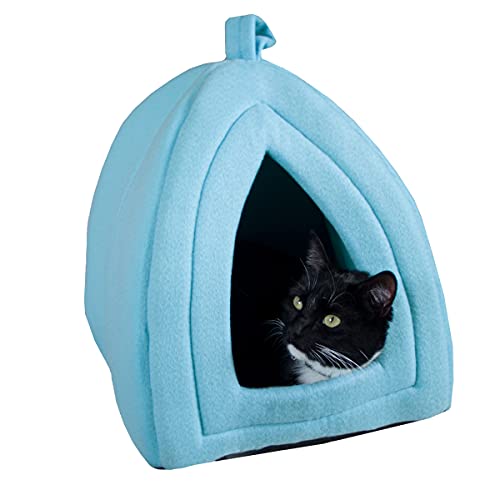Bringing a new cat home is often accompanied by visions of purrs, cuddles, and instant feline friendship. The reality, however, can sometimes be a little less harmonious, especially if you already have resident pets or a family unused to feline ways. The dream of effortless integration can quickly turn into hissing standoffs and bewildered hiding if the introduction process is rushed or not approached with the right understanding. Cats, by their very nature, are creatures of habit and deeply connected to their territory. Change, especially the arrival of a stranger into their established domain, can be profoundly stressful for them. Rushing a new cat into the household without careful consideration of their needs and the dynamics of your existing family is not only stressful for the new arrival, but can also create significant anxiety and behavioral problems for your current pets, and indeed, for you and your family too.
This article is your comprehensive guide to navigating this delicate process with grace and patience. Our aim is to provide you with a step-by-step approach to safely and successfully introduce a new cat to your family, be they human or already furry. By understanding the feline perspective and following a structured, cat-centric method, we can minimize stress for everyone involved, and significantly increase the chances of creating a peaceful and harmonious home for all your companions. We will walk through the essential preparations you need to make before your new cat even arrives, the crucial early days of settling in, the art of gradual scent and sound introductions, the careful expansion into shared spaces, and finally, how to nurture long-term harmony in your multi-cat household. We will also address common challenges and offer troubleshooting advice, reminding you throughout that patience and a cat-first approach are the cornerstones of a successful integration.
Before your new feline family member even crosses your threshold, laying the groundwork for a smooth transition is absolutely essential. This preparatory phase centers around creating a sanctuary – a “safe room” – for your new cat. This dedicated space will be their haven, their personal retreat where they can de-stress, adjust to the new sights, sounds, and smells of your home, and begin to feel secure without the immediate pressure of interacting with the rest of the household. Think of it as their acclimatization chamber. This safe room should be a quiet, low-traffic area of your home, perhaps a spare bedroom, a guest room, or even a spacious bathroom, provided it has a window for natural light and ventilation. The key is to choose a room where the new cat will be least disturbed and can have some peace and quiet.
Within this safe room, you need to create a complete feline haven. This means providing all the essential resources a cat needs, readily available and comfortably arranged. Start with the basics: food and water bowls, ideally placed away from the litter box area. A litter box, of course, is crucial, and it should be situated in a different area of the room from the feeding station. Cats are fastidious creatures and generally prefer not to eat where they eliminate. Provide a comfortable bed, or several options if you’re not sure of your new cat’s preferences – a cozy, enclosed bed for security, and perhaps a softer, more open bed for lounging. Scratching is a natural and essential cat behavior, so include a sturdy scratching post or pad to allow them to stretch, sharpen their claws, and mark their territory in an appropriate way. Toys are important for enrichment and stress relief, so offer a variety of engaging toys – puzzle feeders, wand toys, soft plush toys, and crinkle balls can all be good choices.
Crucially, within the safe room, ensure there are plenty of hiding places. Cats often feel more secure when they have options to retreat and observe their surroundings from a concealed vantage point. Cardboard boxes of various sizes, upturned pet carriers, and draped blankets over chairs or tables can all create excellent hiding spots. Think about creating vertical space too – a cat tree or even just access to a window perch can provide a sense of security and allow the cat to survey their new domain from above. The more comfortable, safe, and resource-rich this safe room is, the quicker your new cat will settle and the less stressed they will be in these initial critical days.
If you already have resident pets, preparation extends to them as well. Before the new cat even arrives, you can begin the process of scent introduction. Scent is a primary form of communication for cats. Exchanging scents before visual or direct contact can be incredibly helpful in easing tensions and creating a sense of familiarity. If possible, before you even bring your new cat home, try to obtain a blanket or towel from their previous environment that already carries their scent. If this isn't feasible, don’t worry. Once you bring the new cat home and have them settled in their safe room, you can use a clean towel or cloth to gently rub around their face and body (if they are comfortable with this – never force interaction). This will collect their scent. Then, introduce this scent-laden cloth to your existing pets, allowing them to sniff it and become accustomed to the new aroma. Simultaneously, you can take a towel or blanket that your existing pets have used and place it outside the new cat's safe room door, allowing the new cat to start becoming familiar with their scents too. This subtle scent swapping, even before they meet, can significantly reduce the shock of a completely unfamiliar smell when introductions eventually begin.
Beyond scent preparation, ensure your existing pets have their own safe spaces and resources that won’t be disrupted by the newcomer. This means confirming that your current cats or dogs have access to their usual feeding areas, sleeping spots, litter boxes (for cats), and favorite toys without feeling threatened or displaced. This maintains their sense of security and reduces the likelihood of territorial anxieties escalating when the new cat arrives. Finally, and perhaps most importantly, prepare yourself mentally. Introducing a new cat is rarely an overnight success. Patience is not just a virtue, it is absolutely crucial. Understand that the process may take days, weeks, or even months, depending on the personalities of all the cats involved. Be prepared to take things slowly, to celebrate small victories, and to avoid rushing or forcing any interactions. Your calm, patient, and consistent approach will be the most valuable asset in ensuring a successful and harmonious integration.
The first few days after your new cat arrives are all about allowing them to settle into their safe room and de-stress from the journey and the upheaval of moving to a new home. Upon arrival, transport your new cat calmly and quietly directly to their prepared safe room, ideally in a sturdy and secure carrier. Once inside the safe room, place the carrier gently on the floor, open the door, and then simply step back and let the cat emerge at their own pace. Resist the very strong urge to immediately reach in, pet them, or coax them out. They need to feel in control and choose when they are ready to explore their new surroundings. Some cats will cautiously venture out relatively quickly, while others may remain in the carrier for hours or even a day or two, feeling safer within its enclosed confines. Let them dictate the timeline.
Once they have emerged from the carrier, continue to give them space and avoid overwhelming them with attention. Check on them regularly, but do so quietly and unobtrusively. Observe their behavior from a distance. Are they eating and drinking? Are they using the litter box? Are they exploring the room, even if it's just initially exploring their hiding places? These are all positive signs that they are starting to adjust. When you are in the room, speak softly and reassuringly, but avoid making direct eye contact initially, as this can be perceived as threatening by a nervous cat. Let them come to you if and when they feel ready. The first few days are not about intense interaction; they are about providing a calm and secure environment and allowing the new cat to de-stress and begin to feel safe in their haven.
During this initial settling-in period, continue the subtle scent introduction you began before arrival. You can refresh the scent swapping process by again gently rubbing a clean cloth on the new cat’s face and body (if they are comfortable), and then allowing your resident pets to sniff this cloth. Conversely, refresh the cloths carrying the scent of your resident pets and place them near the safe room door for the new cat to investigate at their own pace. This indirect scent exchange continues to build a foundation of familiarity without the pressure of direct contact. Remember, in these early days, visual or direct contact with existing pets is not yet appropriate. The focus remains on allowing the new cat to acclimatize and begin to feel secure in their safe room, while subtly introducing scents to all pets to pave the way for future interactions.
Once your new cat is confidently using their safe room resources, seems more relaxed in your presence, and perhaps even initiates some gentle interaction with you through purrs or rubbing against your legs, you can begin the next phase: controlled scent and sound introductions. This stage is about gradually increasing their awareness of each other without direct physical contact, moving from purely olfactory and auditory cues to very brief, supervised visual glimpses.
A powerful way to create positive associations with scent is through feeding. Start feeding the new cat their meals on one side of the safe room door, and your existing pets on the other side. This proximity allows them to smell each other while associating the scent with something very positive – food. Initially, place the food bowls a little further from the door if you think either cat might be particularly anxious. As they both eat calmly in this arrangement, you can gradually move the bowls closer to the door over the course of a few days. The goal is to create a scenario where they are eating comfortably just on opposite sides of the door, perhaps even with their noses almost touching under the door crack. This reinforces the positive association between the other cat’s scent and a pleasant experience.
In addition to scent, sound is another important sense for cats. Begin brief sound introductions by simply talking to the new cat through the closed safe room door. Let them get used to the sound of your voice and the general sounds of your household activity. Encourage other family members to also speak quietly and calmly near the safe room, so the new cat becomes familiar with all the human voices in their new family. Avoid loud noises or sudden movements near the safe room door, as this could startle the new cat and set back their progress.
Once feeding near the door is going smoothly and both the new cat and your existing pets seem relaxed and accustomed to each other’s sounds, you can consider introducing very brief, supervised visual introductions. These initial peeks should be incredibly short and carefully managed. One method is to crack the safe room door open just slightly for a few seconds at a time, perhaps while you are feeding them on either side of the door, or while distracting them with a toy. Another option is to use a baby gate or a screen door placed across the doorway. This allows for visual interaction but maintains a physical barrier. Keep these initial visual introductions extremely brief, perhaps just seconds at first, and gradually increase the duration as both cats seem comfortable. Throughout these visual introductions, and indeed throughout this entire stage, focus on positive reinforcement. Offer treats and praise to all cats involved while they are in proximity to each other, particularly if they are displaying calm and relaxed body language. The aim is to create positive associations with seeing and being near each other. It is crucial to end each visual introduction session on a positive note, and before any signs of stress, fear, or aggression emerge from any of the cats. If you see hissing, growling, flattened ears, puffed fur, dilated pupils, or tense body posture, immediately separate the cats and slow down the introduction process. Patience is key, and moving at the cat’s pace, rather than forcing interactions, will ultimately lead to a more successful and harmonious integration.
After successful controlled scent, sound, and brief visual introductions, and when all cats involved are consistently displaying relaxed body language and calm reactions, you can start the next phase: gradual exploration and interaction in shared territory. This stage involves carefully expanding the new cat's territory beyond the safe room, and then gradually allowing supervised interactions in shared spaces with your existing pets.
Begin by allowing the new cat short periods of supervised exploration outside of their safe room while your existing pets are securely confined in another room. Open the safe room door and let the new cat venture out to explore the immediate surroundings at their own pace. Do not force them to leave the safe room. Simply open the door and let them decide when and if they are ready to explore. Initially, these exploration periods should be very short, perhaps just 10-15 minutes. Allow the new cat to sniff around, investigate the new smells and textures of your home, and familiarize themselves with the wider environment without the pressure of encountering your resident pets. Throughout this exploration time, remain present and quietly observe their behavior, offering soft reassurance if needed. After the allotted exploration time, gently guide the new cat back to their safe room, using a favorite toy or treat as encouragement, and close the door. Gradually increase the duration of these supervised exploration periods as the new cat becomes more confident and comfortable venturing outside of their safe room.
Once the new cat is confidently exploring outside of their safe room while your existing pets are secured, you can move to the next, and often most delicate, step: supervised shared space introductions with all cats present. These initial shared space encounters should be extremely short, highly supervised, and carefully structured to maximize positive interactions and minimize potential conflict. Start with very brief sessions, perhaps just 5-10 minutes at first, with all cats in the same room. Ensure that there are plenty of distractions and resources available in the shared space to minimize competition and keep the interactions positive. Scatter treats around the room, engage the cats in play with separate wand toys, and provide multiple comfortable resting spots at different levels (floor, cat trees, chairs). Closely monitor the body language of all cats throughout these shared space sessions. Watch for any signs of stress, fear, or aggression in any of the cats: hissing, growling, swatting, puffed fur, flattened ears, dilated pupils, tense posture, tail swishing or twitching. At the first sign of rising tension in any cat, immediately and calmly separate them, returning the new cat to their safe room. It is crucial to end these shared space sessions before any conflict arises, and always on a positive note. Use positive reinforcement liberally throughout these sessions, offering treats, praise, and gentle petting (if the cats are receptive) when they are interacting calmly or even just coexisting peacefully in the same space.
As these supervised shared space introductions progress successfully, and all cats are consistently displaying relaxed body language and peaceful coexistence, you can gradually increase the duration and frequency of shared space time. Continue to provide plenty of individual resources – food bowls, water bowls, litter boxes, beds, scratching posts – in multiple locations throughout your home, even outside of the safe room, to reduce potential resource competition and ensure all cats feel secure and have access to their needs. Initially, maintain separate feeding areas for all cats, even as they begin to coexist more freely, to further minimize any potential for food-related aggression. Throughout this entire process, remember to let the cats set the pace. Do not force interactions or rush the timeline. Allowing them to gradually build trust and familiarity at their own speed is the key to long-term harmonious coexistence.
Recognizing success in a multi-cat introduction is not always about instant, cuddly friendships. Often, successful integration looks like peaceful coexistence. Signs of successful integration include cats coexisting calmly in the same space, ignoring each other without tension, and gradually, perhaps, engaging in positive interactions like playing together or mutual grooming. While some cats may develop close “buddy” relationships, this is not always the outcome, or even the goal. Peaceful coexistence, where cats can comfortably share the same home without stress or conflict, is a significant achievement and a very successful outcome.
Maintaining harmony in a multi-cat household is an ongoing process, even after the initial introductions are complete. It is crucial to continue providing ample individual resources for each cat – multiple feeding stations, water bowls, litter boxes, beds, scratching posts – even after they are living together harmoniously. This reduces competition and ensures each cat always feels secure that their needs will be met. Regular playtime and individual attention for each cat are also essential. Even if the cats are now interacting positively with each other, they still need individual attention, play, and bonding time with you. This reinforces your bond with each cat and helps prevent any feelings of jealousy or displacement. Continuously monitor the dynamics within your multi-cat household. Be alert for any shifts in behavior, any signs of renewed stress, or any subtle changes in the relationships between the cats over time. Life events, changes in routine, or even just the natural aging process can sometimes alter feline dynamics. Being observant allows you to address any potential issues early before they escalate into conflict. Creating and maintaining a calm and enriching environment for all your cats is paramount. This means providing plenty of vertical space, scratching opportunities, toys, and puzzle feeders to keep them mentally stimulated and physically satisfied, minimizing boredom and stress which can contribute to inter-cat conflict.
If you have children in your family, involving them appropriately in the introduction process is crucial. Teach children about cat body language and the importance of respecting cat boundaries. Explain to them that the new cat may be scared and needs gentle, quiet interactions. Supervise children’s interactions with the new cat, especially in the early stages. Encourage gentle and calm interactions, such as quiet talking, slow hand movements, and allowing the cat to approach them, rather than chasing or forcing interaction. Teach them how to recognize signs of cat stress or fear and to give the cat space when needed. Involving children in a responsible and respectful way can foster positive relationships between them and the new cat, and contribute to a harmonious family environment for everyone.
Even with the most careful and patient introductions, challenges can arise. It's important to remember that setbacks are normal and to know how to troubleshoot common issues. Hissing and growling, especially in the initial stages, are often normal communication signals. They don’t necessarily indicate aggression, but rather that the cats are establishing boundaries and expressing their feelings. Distinguish between normal communication hissing and growling, and excessive or prolonged aggression. If hissing and growling are infrequent and brief, it’s often part of the adjustment process. However, if it is constant, intense, or escalating, it’s a sign that you need to slow down the introduction process and potentially seek professional advice. Hiding is also a common behavior for a new cat, especially initially. Allowing a new cat to hide is crucial, as it provides them with a sense of security. However, if a cat is hiding excessively for prolonged periods (days or weeks) and not eating, drinking, or using the litter box, this is a cause for concern. To encourage exploration, make sure hiding places are comfortable and accessible, and gently encourage them to come out with enticing toys or food, but never force them out of their hiding place.
Resource guarding, where a cat becomes overly protective of food, water, litter boxes, or resting spots, can also emerge during introductions. To address resource guarding, ensure there are ample resources available in multiple locations, widely dispersed, so cats don’t feel the need to compete. Feed cats in separate areas initially, and gradually move feeding stations closer only when all cats are comfortable. If progress seems stalled, and the cats are not showing signs of becoming more comfortable with each other despite your patient efforts, it may be time to re-evaluate your approach and potentially slow down the introduction process even further. Go back a step or two in the introduction stages and spend more time on scent and sound introductions before attempting visual or shared space interactions.
In some cases, despite your best efforts, aggression may be severe or persistent, or cats may exhibit signs of extreme stress for prolonged periods. If you encounter these situations, it is wise to seek professional help. Consulting your veterinarian is a good first step, to rule out any underlying medical issues that might be contributing to behavioral problems. Your veterinarian can also refer you to a certified cat behaviorist or a veterinary behaviorist. These professionals have specialized knowledge and experience in feline behavior and can provide tailored advice and strategies to address complex introduction challenges.
Ultimately, successful cat introductions hinge on patience and a cat-centric approach. Remember that every cat is an individual with their own personality, history, and comfort level. Introductions are not a race, and rushing the process can be detrimental, setting back progress and potentially damaging relationships. Embrace the slow, gradual method, be observant of feline body language, and prioritize the comfort and well-being of all your cats throughout the process.
Introducing a new cat to your family is a journey, not a sprint. By following a step-by-step approach, focusing on gradual introductions, and prioritizing patience and a cat-centric perspective, you significantly increase your chances of creating a harmonious and loving multi-cat household. Remember the key stages: preparation with a safe room, the crucial settling-in period, controlled scent and sound introductions, gradual visual glimpses, and finally, the careful expansion into shared spaces. The benefits of this slow and patient method are immense: reduced stress for all your feline companions, a much higher likelihood of a peaceful multi-cat home, and ultimately, happier, more relaxed cats and a more joyful family for you. While introducing a new cat takes time, dedication, and understanding, the reward is well worth the effort – a loving, peaceful home where all your feline family members can thrive and bring joy to your lives for years to come.







